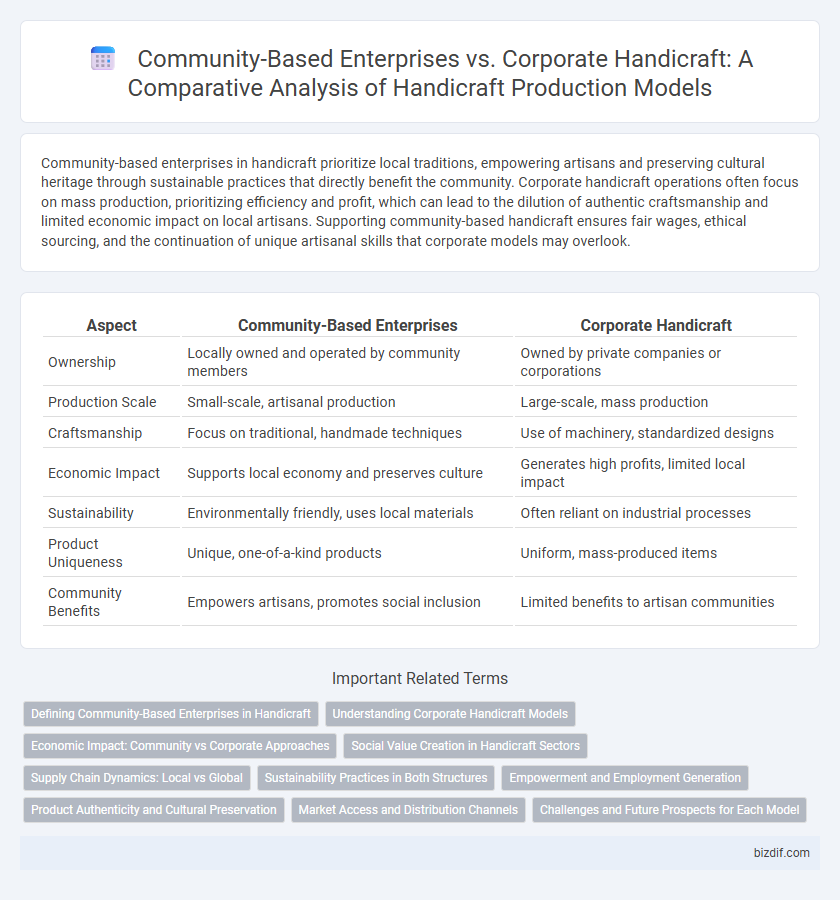Community-based enterprises in handicraft prioritize local traditions, empowering artisans and preserving cultural heritage through sustainable practices that directly benefit the community. Corporate handicraft operations often focus on mass production, prioritizing efficiency and profit, which can lead to the dilution of authentic craftsmanship and limited economic impact on local artisans. Supporting community-based handicraft ensures fair wages, ethical sourcing, and the continuation of unique artisanal skills that corporate models may overlook.
Table of Comparison
| Aspect | Community-Based Enterprises | Corporate Handicraft |
|---|---|---|
| Ownership | Locally owned and operated by community members | Owned by private companies or corporations |
| Production Scale | Small-scale, artisanal production | Large-scale, mass production |
| Craftsmanship | Focus on traditional, handmade techniques | Use of machinery, standardized designs |
| Economic Impact | Supports local economy and preserves culture | Generates high profits, limited local impact |
| Sustainability | Environmentally friendly, uses local materials | Often reliant on industrial processes |
| Product Uniqueness | Unique, one-of-a-kind products | Uniform, mass-produced items |
| Community Benefits | Empowers artisans, promotes social inclusion | Limited benefits to artisan communities |
Defining Community-Based Enterprises in Handicraft
Community-based enterprises in handicraft operate through local artisans and craftspersons, emphasizing cultural preservation, sustainable practices, and community empowerment. These enterprises prioritize traditional techniques and local materials, creating economic opportunities while maintaining authentic craftsmanship. They contrast with corporate handicraft models by focusing on equitable profit distribution and fostering social development within the community.
Understanding Corporate Handicraft Models
Corporate handicraft models emphasize scalability, standardization, and market reach, often leveraging mass production techniques and global distribution channels. These models tend to prioritize profit maximization and brand consistency while sometimes compromising the authenticity and cultural significance of traditional crafts. Understanding these corporate frameworks reveals the trade-offs between commercial efficiency and preserving the unique heritage inherent in community-based handicraft enterprises.
Economic Impact: Community vs Corporate Approaches
Community-based handicraft enterprises generate localized economic benefits by empowering artisans and retaining profits within the community, fostering sustainable livelihoods and cultural preservation. In contrast, corporate handicraft operations often prioritize mass production, leading to economic gains concentrated in corporate centers while potentially marginalizing individual artisans. The community approach enhances social equity and economic resilience, whereas corporate models drive scalability and broader market reach but may reduce local economic diversification.
Social Value Creation in Handicraft Sectors
Community-based enterprises in the handicraft sector prioritize social value creation by empowering local artisans, preserving cultural heritage, and promoting fair trade practices. These enterprises foster sustainable livelihoods and strengthen community cohesion by reinvesting profits locally and supporting skill development. In contrast, corporate handicraft businesses often focus on mass production and profit maximization, which can lead to commodification of traditional crafts and reduced social impact.
Supply Chain Dynamics: Local vs Global
Community-based handicraft enterprises benefit from localized supply chains that prioritize sustainable sourcing, craftsmanship, and direct relationships with artisans, fostering economic empowerment within their communities. In contrast, corporate handicraft supply chains often span global networks, emphasizing scalability, cost efficiency, and mass production, which can dilute traditional techniques and reduce artisan involvement. The localized approach supports biodiversity and cultural heritage, while global chains optimize distribution but may face challenges related to traceability and ethical sourcing.
Sustainability Practices in Both Structures
Community-based enterprises prioritize sustainable practices by utilizing locally sourced materials and traditional techniques that minimize environmental impact and support biodiversity. Corporate handicraft operations often implement standardized sustainability protocols, incorporating advanced waste management systems and scalable eco-friendly sourcing, but may face challenges in preserving cultural authenticity. Both structures contribute to sustainability, with community enterprises fostering social equity and corporate entities driving innovation in green production processes.
Empowerment and Employment Generation
Community-based enterprises in the handicraft sector directly empower artisans by fostering skill development, preserving traditional craftsmanship, and ensuring fair wages, which enhances local livelihoods. These enterprises generate sustainable employment opportunities by integrating marginalized groups, especially women and rural populations, into value chains. Corporate handicraft models, while larger in scale, often prioritize profit over artisan welfare, resulting in less inclusive employment and limited community empowerment.
Product Authenticity and Cultural Preservation
Community-based handicraft enterprises prioritize product authenticity by preserving traditional techniques and cultural narratives passed through generations, ensuring each item reflects genuine heritage and craftsmanship. These enterprises actively involve local artisans, fostering cultural preservation and sustainable livelihoods while maintaining unique regional identities. In contrast, corporate handicraft often standardizes production processes for mass markets, risking dilution of cultural authenticity and the loss of distinct artisanal characteristics.
Market Access and Distribution Channels
Community-based enterprises in handicraft often leverage local networks and cultural authenticity to access niche markets and build trust with buyers, enhancing product value through storytelling and traditional craftsmanship. Corporate handicraft businesses utilize extensive distribution channels including e-commerce platforms, international trade fairs, and retail chains, enabling broader market reach and higher volume sales. Market access for community enterprises is frequently limited by resource constraints, while corporations benefit from established logistics and marketing strategies that facilitate global scalability.
Challenges and Future Prospects for Each Model
Community-based handicraft enterprises face challenges such as limited access to capital, inconsistent supply chains, and market reach constraints but benefit from authentic cultural preservation and local empowerment. Corporate handicraft models struggle with maintaining artisan authenticity and ethical sourcing while leveraging advanced technology, global distribution, and investment capacity. Future prospects for community enterprises lie in digital marketplaces and fair-trade certifications, whereas corporate models aim to integrate sustainable practices and mass customization to meet evolving consumer demands.
Community-Based Enterprises vs Corporate Handicraft Infographic

 bizdif.com
bizdif.com